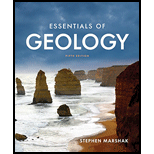
The formation of clastic sedimentary rock from its unweathered parent rock.
Answer to Problem 1RQ
The process of formation of clastic sedimentary rock from its unweathered parent rock occurs with the weathering and erosion of the parent rock followed by of these transportation and deposition of these sediments through natural agents and finally the lithification sediments forming a complete rock.
Explanation of Solution
The erosion, transportation and deposition and subsequent compaction of sediments by the natural agents such as wind, water etc form the sedimentary rocks mostly. Calstic sedimentary rocks are the ones in which the loose clasts(individual minerals or rock pieces) are grouped together and are compacted.
Clastic sedimentary rocks are formed from its unweathered parent rock through multiple steps of transformations.
- Weathering is a phenomenon in which the bedrock disintegrates into grains due to physical or chemical processes.
- Erosion of weathered particles takes place in where, the pieces of rock or surface debris is detached from the surface. This is acted upon by the natural agents such as air, water or ice.
- These natural geological agents transport the eroded particles acting as a medium of transport. The rate of transportation depends on many factors such as viscosity, velocity of the medium etc.
- The deposition of these sediments take place when the velocity of the transportation medium totally slow down.
- Liithification is a process of transformation of these loose sediments into a solid rock. At first compaction of sediments takes place followed by the cementation of these sediments by the cementing materials such as quartz or calcite mostly. These are formed by the precipitation of groundwater and fills the remain space between the sediments, binding them together.
Want to see more full solutions like this?
Chapter 6 Solutions
Essentials of Geology (Fifth Edition)
- Subject: Hydrogeology Please answer both parts of the question correctly and in detail and show all workarrow_forwardDiscussion Question: Climate Change A+ The link below explains how scientists study past climates. After the introduction, there are 6 more links within the web page. Please go over each of the six links. Then, write one paragraph about each link explaining what you learned in your own voice. You should end up with 6 paragraphs total. http://earthobservatory.nasa.gov/Features/Paleoclimatology/paleoclimatology_intro.php Please always write in your own words and hence, your own voice. Plagiarism is completely unnecessary.arrow_forward1. List the five REASONS for seasons. Please be careful. I am not looking for INFLUENCES on seasons such as, Global Warming and winds. Think about axial parallelism, for example. (20 points). 2. Are we closest to the sun during the Northern Hemisphere summer or winter (5 points)? Is it called the aphelion or the perihelion (5 points)? 3. When does everyone receive 12 hours of day and 12 hours of night (5 points)? 4. During what Northern Hemisphere season do the penguins in Antarctica (the Southern Hemisphere) receive 24 hours of darkness (5 points)? 5. The water molecule is polar with two offset hydrogen atoms bonded to one oxygen atom. What are two characteristics or properties of the water molecule due to its polarity (10 points)? 6. The dew point temperature is 68 degrees Fahrenheit. Relative humidity is at 50%. Saturation vapor pressure is 24 millibars. What is the actual vapor pressure in the air in units of millibars? It is not a trick question. Look in the textbook under…arrow_forward
- Discussion Question: Ecosystems Essentials A+ of 1000 Exof-spil OCEAN The Human Denominator Assignment As we learn about how the earth works, we learn to identify the different earth spheres and how they overlap and affect one another. An understanding of the Earth's systems and spheres takes practice. More importantly, we can see the "Domino Effect" of the spheres as they interact with one another. We have learned that while endogenic processes are separate from exogenic process, the lithosphere affects the atmosphere which affects the hydrosphere, and the biosphere. Now, we can reverse the situation and consider how the biosphere, you and I, affectarrow_forwardGo to the following link. https://climate.nasa.gov/evidence/ Read over all of the links about the Climate Evidence, Causes, and Effects. Then, write a 15-20 sentences about what you learned.arrow_forwardPart C. Can someone draw and explain the steps to help with my understanding.arrow_forward
 Applications and Investigations in Earth Science ...Earth ScienceISBN:9780134746241Author:Edward J. Tarbuck, Frederick K. Lutgens, Dennis G. TasaPublisher:PEARSON
Applications and Investigations in Earth Science ...Earth ScienceISBN:9780134746241Author:Edward J. Tarbuck, Frederick K. Lutgens, Dennis G. TasaPublisher:PEARSON Exercises for Weather & Climate (9th Edition)Earth ScienceISBN:9780134041360Author:Greg CarbonePublisher:PEARSON
Exercises for Weather & Climate (9th Edition)Earth ScienceISBN:9780134041360Author:Greg CarbonePublisher:PEARSON Environmental ScienceEarth ScienceISBN:9781260153125Author:William P Cunningham Prof., Mary Ann Cunningham ProfessorPublisher:McGraw-Hill Education
Environmental ScienceEarth ScienceISBN:9781260153125Author:William P Cunningham Prof., Mary Ann Cunningham ProfessorPublisher:McGraw-Hill Education Earth Science (15th Edition)Earth ScienceISBN:9780134543536Author:Edward J. Tarbuck, Frederick K. Lutgens, Dennis G. TasaPublisher:PEARSON
Earth Science (15th Edition)Earth ScienceISBN:9780134543536Author:Edward J. Tarbuck, Frederick K. Lutgens, Dennis G. TasaPublisher:PEARSON Environmental Science (MindTap Course List)Earth ScienceISBN:9781337569613Author:G. Tyler Miller, Scott SpoolmanPublisher:Cengage Learning
Environmental Science (MindTap Course List)Earth ScienceISBN:9781337569613Author:G. Tyler Miller, Scott SpoolmanPublisher:Cengage Learning Physical GeologyEarth ScienceISBN:9781259916823Author:Plummer, Charles C., CARLSON, Diane H., Hammersley, LisaPublisher:Mcgraw-hill Education,
Physical GeologyEarth ScienceISBN:9781259916823Author:Plummer, Charles C., CARLSON, Diane H., Hammersley, LisaPublisher:Mcgraw-hill Education,





